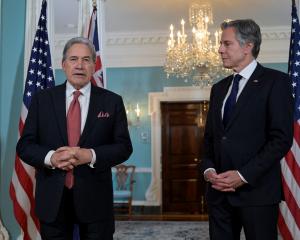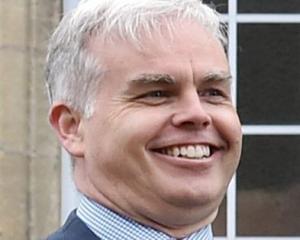Was Meridian Energy's decision late last week to shelve its $2 billion Project Hayes wind farm in Central Otago a lost opportunity for establishing renewable energy in this country on a grand scale - or simply a "prudent commercial decision" by the power company giant?
Malcolm Macpherson, whose Central Otago District Council granted consent for the project originally, and the Save Central environmental lobby group, as represented by Grahame Sydney, BrianTurner, Graye Shattky and Anton Oliver, were invited by the Otago Daily Times to provide opinions from both sides of a debate that divided communities.
Meridian claimed the Lammermoor Range offered a wind resource superior to that of many international sites and, consequently, Project Hayes would provide economic benefits to both the region and the nation by way of electricity production worth $157.3 million a year, improved security of electrical supply and direct and indirect benefits to the region amounting to $840 million and 380 jobs during the construction phase. Once operational, Project Hayes was to make an annual contribution of $2 million-$3 million and provide 2835 jobs.
Those now venting their dismay at Meridian's withdrawal must ask themselves: "If it was as good as they said it would be, why surrender?"
Certainly, it wasn't because of Save Central's determined opposition or because of the legal costs: these were always much more of a problem for Save Central than for a large corporation.
No, the fact is Mr Binns has tacitly acknowledged Meridian got it wrong.
Project Hayes never "stacked up" as a viable commercial venture. If Meridian believed in the depths of its organisational heart that the monster project was a certain money-maker, that it was indeed everything its spin department said it was at the outset, it would surely never have withdrawn.
It is a corporate, remember, not a social service. Meridian is not responsible for security of energy supply: thanks to the electricity reforms in 1999, its primary responsibility is to its shareholders. To dish up as decent a dividend as possible. Money, not welfare.
But Project Hayes was always more of a symbol of New Zealand's supposed leadership in renewables than a sound investment. Spending close to $2 billion, and the cost of servicing that borrowing, requires a degree of long-term confidence and conviction Meridian's executives and advisers were unable to bring to Project Hayes, and in the event of the partial sale of the SOE, no institutional investor would want a bar of such an enormous investment risk unless the numbers stacked up.
That fact comes as no surprise to Save Central members; from the first announcement of Project Hayes, local observers held strong reservations about the frequency and reliability of wind in Central Otago, which consequently led to questions as to whether sacrificing the outstanding values of the Lammermoor landscape for a 92sq km industrial-scale wind farm could be justified.
Subsequently, despite Meridian's refusal to provide substantive wind data to prove their case and the dissenting legal view of Commissioner Mathews, the Central Otago District Council and the Otago Regional Council ignored evidence regarding the potentially adverse effects of the project on an outstanding landscape, heritage sites and the environment and approved the resource consents requested by Meridian Energy.
Save Central and others appealed that decision to the Environment Court, not, as critics assume, because of any ideological opposition to wind farms generally, but simply because it considered that Project Hayes was an inappropriate, giant industrial scheme in the wrong place. This view was subsequently confirmed by the Environment Court's finding that the Lammermoor Range is indeed an "outstanding landscape" and its decision to refuse Meridian the resource consents it required.
But those anxious about the future security of electricity supply in this country needn't lose any sleep.
Meridian is busy without Hayes; it has plenty "more prudent" (as its website confesses) projects on their books: their North Bank Waitaki hydro plan is close to seeking consents, the highly contentious Mokihinui River hydro dam is under appeal, and there are the Mill Creek and Mt Munro wind estates in the lower North Island, plus the Amuri wind and Hurunui hydro schemes in North Canterbury, both of which are also destined to face serious opposition.
Meridian is also building a joint-venture 140-turbine wind farm at MacArthur in Western Victoria - the instant replacement for the proud boast originally attached to Project Hayes - "the southern hemisphere's biggest".
Competing generators are busy, too: Contact Energy continues to dream of its proposals to further degrade and dam the remaining naturally flowing sections of the Clutha River at Beaumont, Queensberry and Luggate.
Trustpower has installed 12 of its wind turbines at Mahinerangi, the actual output of which is yet to be revealed, and speaks of expansion there. But hydro is its real delight: new schemes are planned for the Wairau River in Marlborough (consented) and the Arnold River in Westland, near Lake Brunner.
Interestingly, just last week Trustpower complained that four of its company's projects had been held up not by opposition but by the prohibitive costs of using the high-voltage direct-current cable across Cook Strait.
The cable is tired and inadequate; it can't take increased load. Big schemes in the South, built to power the expanding North, are, or should be, a thing of the distant past. Growth in demand is sluggish, and the majority of that predicted growth is north of Hamilton. Fortunately, that is where vast resources of geothermal energy exist, the perfect marriage of renewable energy close to demand.
Of course, there is always the option of returning Manapouri's massive output to the taxpayers who funded the scheme in the first place - now there's something for Meridian to ponder!The energy corporations are proving reluctant to accept the profound changes we will have to make in the way we lead our lives in the near future. The next decade will see a radical change in the nature of energy generation in this country; technological advances (improved photovoltaic, solar nanotechnology, tidal generation and micro wind) will all enable distributed energy, small-scale provision from a variety of sources close to demand.
Meridian's decision to abandon Project Hayes has averted what was likely to be a tragic, short-sighted mistake.
It is now up to us all to ensure that no other grandiose scheme driven by corporate ego and the pursuit of profit should dam another river or unnecessarily despoil any other significant landscape.
- Graye Shattky, Grahame Sydney, Brian Turner, and Anton Oliver












